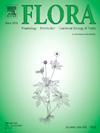渗透孔在双色Caladium(天南星科)传粉中的作用:结构分析
IF 1.8
4区 生物学
Q3 ECOLOGY
引用次数: 0
摘要
所有已知的Caladieae部落的物种都是甲虫授粉的,与产热有关的花挥发物在吸引传粉者方面起着关键作用。在Caladium双色中,花序散发出强烈的气味,吸引夜间的环头甲虫,尽管气味散发的确切位置仍有争议。本研究鉴定了渗透孔,并检查了与气味产生有关的组织和亚细胞结构。初步观察表明,芳香来源是蝶骨的雄蕊部分。显微分析显示,分泌区由乳头状表皮和下面的分泌薄壁组织组成。气孔有渗出物释放的迹象。在产热高峰期间,薄壁组织中的淀粉储备减少,并构成该过程的能量来源。双胞体的远端部分显示细胞质富含线粒体、质体和其他细胞器的细胞。除了在产热过程中起基础作用外,线粒体与质体一起,在一些花束成分的生物合成中起关键作用,主要是萜烯。这种细胞结构,加上可育雄蕊部分活跃的渗出液生产和明显的产热作用,有力地支持了它作为花香释放主要部位的作用。本文章由计算机程序翻译,如有差异,请以英文原文为准。
Osmophores as key players in pollination of Caladium bicolor (Araceae): a structural approach
All known species of the Caladieae tribe are beetle-pollinated, with floral volatiles linked to thermogenesis playing a key role in attracting pollinators. In Caladium bicolor, the inflorescences emit a strong scent that attracts nocturnal cyclocephaline beetles, though the exact site of scent emission remains debated. This study identified the osmophore and examined tissues and subcellular structures involved in scent production. Preliminary observations indicated the staminate portion of the spadix as the scent source. Microscopic analyses revealed that the secretory region is composed of papillary epidermis and underlying secretory parenchyma. Stomata exhibited signs of exudate release. Starch reserves in the parenchyma decreased during peak thermogenesis and constitute the energy source for this process. The distal portion of the synandria exhibited cells with cytoplasm rich in mitochondria, plastids, and other organelles. In addition to being fundamental in the process of thermogenesis, mitochondria, in association with plastids, plays a key role in the biosynthesis of some components of the floral bouquet, primarily terpenes. The cell structure, combined with active exudate production and pronounced thermogenesis in the fertile staminate portion, strongly supports its role as the primary site of floral fragrance emission.
求助全文
通过发布文献求助,成功后即可免费获取论文全文。
去求助
来源期刊

Flora
生物-植物科学
CiteScore
3.30
自引率
10.50%
发文量
130
审稿时长
54 days
期刊介绍:
FLORA publishes original contributions and review articles on plant structure (morphology and anatomy), plant distribution (incl. phylogeography) and plant functional ecology (ecophysiology, population ecology and population genetics, organismic interactions, community ecology, ecosystem ecology). Manuscripts (both original and review articles) on a single topic can be compiled in Special Issues, for which suggestions are welcome.
FLORA, the scientific botanical journal with the longest uninterrupted publication sequence (since 1818), considers manuscripts in the above areas which appeal a broad scientific and international readership. Manuscripts focused on floristics and vegetation science will only be considered if they exceed the pure descriptive approach and have relevance for interpreting plant morphology, distribution or ecology. Manuscripts whose content is restricted to purely systematic and nomenclature matters, to geobotanical aspects of only local interest, to pure applications in agri-, horti- or silviculture and pharmacology, and experimental studies dealing exclusively with investigations at the cellular and subcellular level will not be accepted. Manuscripts dealing with comparative and evolutionary aspects of morphology, anatomy and development are welcome.
 求助内容:
求助内容: 应助结果提醒方式:
应助结果提醒方式:


